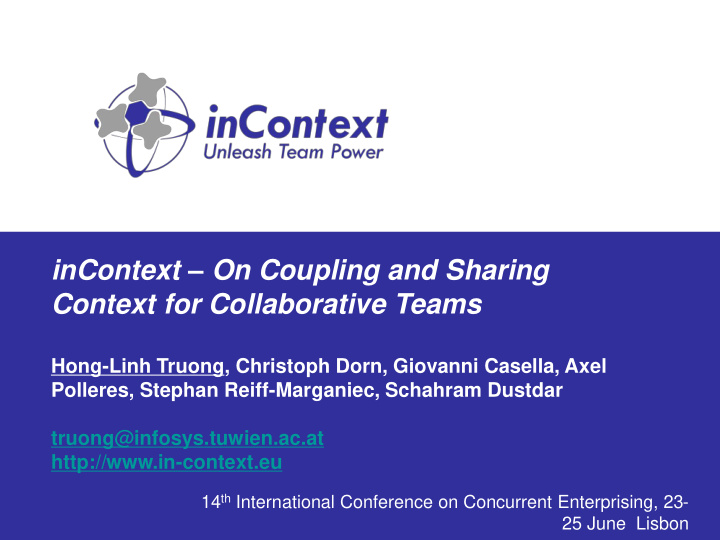



inContext – On Coupling and Sharing Context for Collaborative Teams Hong-Linh Truong, Christoph Dorn, Giovanni Casella, Axel Polleres, Stephan Reiff-Marganiec, Schahram Dustdar truong@infosys.tuwien.ac.at http://www.in-context.eu 14 th International Conference on Concurrent Enterprising, 23- 25 June Lisbon
Outline Motivation Design time context coupling Runtime context coupling Ilustrating examples Conclusion and future work 23-25 June 2008, Lisbon, 14th ICE www.in-context.eu 2
inContext Consortium Coordinated by TU Wien (AT) 13 June 2008, Brussels 3
Motivation - Today’s Pervasive Collaboration Services A user needs different services even for a single activity How to enable services from different providers to become aware of the overall collaboration context • Services need context from preceeding „steps“ • Services should require minimum user interventions 23-25 June 2008, Lisbon, 14th ICE www.in-context.eu 4
Context Coupling and Sharing E-professional knows his/her part of collaborative process • links between actions, relations between users, relevant resources, artifacts, etc. However, services are limited to compositions within applications Context coupling techniques enrich services with overall collaboration context and link context across user boundaries 23-25 June 2008, Lisbon, 14th ICE www.in-context.eu 5
Supports for Context-aware Collaboration Services To enable context-aware collaboration services • Need to have explicit context information models – Well-defined models for associating diverse types of context in today‘s team collaboration • Need a mechanism to correlate and manage context for collaboration services – Service independent approach – Across distributed, service-based environments This paper focuses on • Context coupling techniques at design-time and runtime for SOAP-based collaboration services 23-25 June 2008, Lisbon, 14th ICE www.in-context.eu 6
Requirements for Context Coupling Need both design-time and runtime context coupling techniques • Collaboration context across user boundaries 23-25 June 2008, Lisbon, 14th ICE www.in-context.eu 7
Design-time Context Coupling Model individual context, team context and activity context using RDF Support flexible and extensibe models by including domain-specific context models and reusing common RDF context models 23-25 June 2008, Lisbon, 14th ICE www.in-context.eu 8
Runtime Context Coupling Techniques Supporting distributed context management Using URI to retrieve context information • ActivityURI and UserURI Embedding URIs specifying context information into SOAP message header • No application-specific source code • Extensible mechanism Supporting RDF/XML context Information • XSPARQL for querying context data and transforming RDF to XML SPARQL Engine/Context store 23-25 June 2008, Lisbon, 14th ICE www.in-context.eu 9
Runtime Context Coupling Techniques (cont.) 23-25 June 2008, Lisbon, 14th ICE www.in-context.eu 10
Runtime Context Coupling Techniques (cont.) <?xml version="1.0" encoding="UTF-8"?> <soapenv:Envelope … <soapenv:Header> <ns1:ctxtunnelling soapenv:actor="http://schemas.xmlsoap.org/soap/actor/next" soapenv:mustUnderstand="0" xmlns:ns1="www.in-context.eu"> <ns1:Activity> http://www.in-context.eu/pcsa#act1 </ns1:Activity> <ns1:User> http://www.in-context.eu/pcsa#Rossi.E54 </ns1:User> </ns1:ctxtunnelling> </soapenv:Header> <soapenv:Body> ... </soapenv:Body> </soapenv:Envelope> 23-25 June 2008, Lisbon, 14th ICE www.in-context.eu 11
Runtime Context Coupling Techniques (cont.) Context Tunneling Handler • SOAP Header extensions: carry over User/Activity ID in service calls, enables tunnelling, monitoring, mining • Prototypes for AXIS1, AXIS2 and .NET • Context aware services can exploit it, but no obligation no specific change for services • Enable context ranking and constraints Different high-level interfaces to the Context Store • getContext(XML, XSPARQL) • setContext(XML,SPARUL) 23-25 June 2008, Lisbon, 14th ICE www.in-context.eu 12
Illustrating Example 23-25 June 2008, Lisbon, 14th ICE www.in-context.eu 13
Conclusion and Future Work inContext techniques for coupling and sharing context for today‘s collaboration services • Developed generic RDF/OWL-based context models • Provided generic runtime service-based context coupling framework: SOAP header extensions, distributed context management, XSPARQL • Based on multidisciplinary research efforts: Web services engineering + ontology/semantics + collaborative computing Working on a reference architecture for context-aware collaboration services Utilizing context coupling and sharing techniques for the FP7 COIN IP to support human interactions in collaboration 23-25 June 2008, Lisbon, 14th ICE www.in-context.eu 14
Further information Mail: truong@infosys.tuwien.ac.at inContext project: http://www.in-context.eu What: the inContext demo, much more than this talk When: Tue, 24 (tomorrow) - during the coffee breaks - at 10 am and 15 pm Where: the coffee room Who: you and the inContext team How: live demo and discussion 23-25 June 2008, www.in-context.eu 15 Lisbon, 14th ICE
Recommend
More recommend